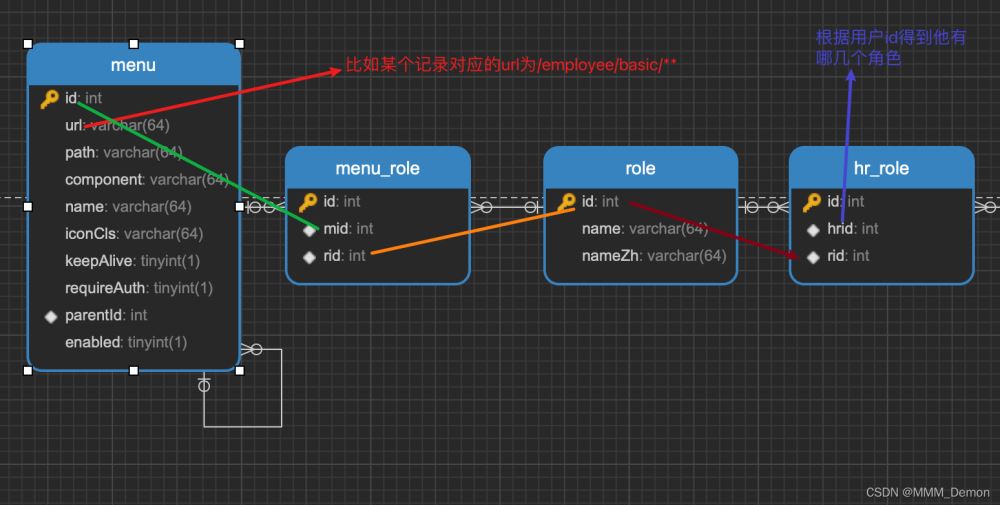这篇文章主要介绍了如何使用SpringSecurity实现动态加载权限信息,具有一定借鉴价值,感兴趣的朋友可以参考下,希望大家阅读完这篇文章之后大有收获,下面让小编带着大家一起了解一下。
①数据库中资源与角色对应关系,以及角色和用户对应关系如下图所示:

②实现FilterInvocationSecurityMetadataSource类
(1)List<Menu> menus = menuService.getMenusWithRoles();这个是你自己的资源对应角色的查询方法。
(2)重写的support方法都返回true
@Configuration public class MyFilterInvocation implements FilterInvocationSecurityMetadataSource { @Autowired private MenuService menuService; AntPathMatcher antPathMatcher = new AntPathMatcher(); @Override public Collection<ConfigAttribute> getAttributes(Object object) throws IllegalArgumentException { String requestUrl = ((FilterInvocation) object).getRequestUrl(); List<Menu> menus = menuService.getMenusWithRoles(); //- 遍历数据库的url,看请求路径是否与其匹配 for (Menu menu : menus) { //- 如果请求路径和数据库的路径匹配 if (antPathMatcher.match(menu.getUrl(),requestUrl)){ //- 访问该路径需要的角色 List<Role> roles = menu.getRoles(); String[] strs = new String[roles.size()]; for (int i = 0; i < roles.size(); i++) { strs[i] = roles.get(i).getName(); } return SecurityConfig.createList(strs); } } //- 如果请求路径和数据库的所有路径都不匹配,说明这个资源是登录后即可访问的 //- 用户登录即可访问,相当于在SecurityConfig中配置了.anyRequest().authenticated() return SecurityConfig.createList("ROLE_LOGIN"); } @Override public Collection<ConfigAttribute> getAllConfigAttributes() { return null; } @Override public boolean supports(Class<?> clazz) { return true; } }③实现AccessDecisionManager类
重写的support方法都返回true
@Configuration public class MyDecisionManager implements AccessDecisionManager { @Override public void decide(Authentication authentication, Object object, Collection<ConfigAttribute> configAttributes) throws AccessDeniedException, InsufficientAuthenticationException { for (ConfigAttribute configAttribute : configAttributes) { String needRole = configAttribute.getAttribute(); if ("ROLE_LOGIN".equals(needRole)) { //- 用户登录即可访问,相当于在SecurityConfig中配置了.anyRequest().authenticated() if (authentication instanceof AnonymousAuthenticationToken) { throw new AccessDeniedException("尚未登录,请先登录"); } else { return; } } Collection<? extends GrantedAuthority> authorities = authentication.getAuthorities(); //这里我写的是只要访问该资源的用户具有`访问该资源所需要角色`的其中一个即可 for (GrantedAuthority authority : authorities) { if (authority.getAuthority().equals(needRole)) { return; } } } throw new AccessDeniedException("权限不足,请联系管理员"); } @Override public boolean supports(ConfigAttribute attribute) { return true; } @Override public boolean supports(Class<?> clazz) { return true; } }④到SecurityConfig配置类中完成相应配置
@Autowired private MyDecisionManager myDecisionManager; @Autowired private MyFilterInvocation myFilterInvocation; @Override protected void configure(HttpSecurity http) throws Exception { http.authorizeRequests() .withObjectPostProcessor(new ObjectPostProcessor<FilterSecurityInterceptor>() { @Override public <O extends FilterSecurityInterceptor> O postProcess(O object) { object.setAccessDecisionManager(myDecisionManager); object.setSecurityMetadataSource(myFilterInvocation); return object; } }); http.exceptionHandling().accessDeniedHandler(myAccessDeniedHandler()); } @Bean MyAccessDeniedHandler myAccessDeniedHandler(){ return new MyAccessDeniedHandler(); }⑤可选,实现AccessDeniedHandler类
public class MyAccessDenied implements AccessDeniedHandler { @Override public void handle(HttpServletRequest req, HttpServletResponse resp, AccessDeniedException accessDeniedException) throws IOException, ServletException { resp.setContentType("application/json;charset=utf-8"); PrintWriter pw = resp.getWriter(); pw.write(new ObjectMapper().writeValueAsString(RespBean.error("权限不够,请联系管理员"))); pw.flush(); pw.close(); } }感谢你能够认真阅读完这篇文章,希望小编分享的“如何使用SpringSecurity实现动态加载权限信息”这篇文章对大家有帮助,同时也希望大家多多支持亿速云,关注亿速云行业资讯频道,更多相关知识等着你来学习!
免责声明:本站发布的内容(图片、视频和文字)以原创、转载和分享为主,文章观点不代表本网站立场,如果涉及侵权请联系站长邮箱:is@yisu.com进行举报,并提供相关证据,一经查实,将立刻删除涉嫌侵权内容。